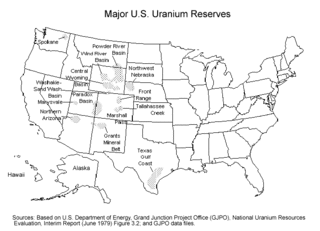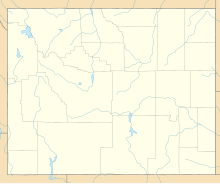Westinghouse Electric Company LLC is an American nuclear power company formed in 1999 from the nuclear power division of the original Westinghouse Electric Corporation. It offers nuclear products and services to utilities internationally, including nuclear fuel, service and maintenance, instrumentation, control and design of nuclear power plants. Westinghouse's world headquarters are located in the Pittsburgh suburb of Cranberry Township, Pennsylvania. Brookfield Business Partners, a Canadian private equity fund and a subsidiary of Brookfield Asset Management is the majority owner of Westinghouse.

The Kerr-McGee Corporation, founded in 1929, was an American energy company involved in oil exploration, production of crude oil, natural gas, perchlorate and uranium mining and milling in various countries. On June 23, 2006, Anadarko Petroleum acquired Kerr-McGee in an all-cash transaction totaling $16.5 billion plus $2.6 billion in debt and all operations moved from their base in Oklahoma, United States.

Wolf Creek Generating Station, a nuclear power plant located near Burlington, Kansas, occupies 9,818 acres (40 km²) of the total 11,800 acres (4,800 ha) controlled by the owner. Wolf Creek, dammed to create Coffey County Lake, provides not only the name, but water for the condensers.

Cameco Corporation is the world's largest publicly traded uranium company, based in Saskatoon, Saskatchewan, Canada. In 2015, it was the world's second largest uranium producer, accounting for 18% of world production.
Orano Cycle, formerly COGEMA and Areva NC, is a French nuclear company. It is the main subsidiary of Orano S.A. It is an industrial group active in all stages of the uranium fuel cycle, including uranium mining, conversion, enrichment, spent fuel reprocessing, and recycling.

National Atomic Company Kazatomprom Joint Stock Company (Kazatomprom) is the world’s largest producer and seller of natural uranium, providing over 40% of global primary uranium supply in 2019 from its operations in Kazakhstan. Kazatomprom's uranium is used for the generation of nuclear power around the world.

Uranium mining in the United States produced 173,875 pounds (78.9 tonnes) of U3O8 in 2019, 88% lower than the 2018 production of 1,447,945 pounds (656.8 tonnes) of U3O8 and the lowest US annual production since 1948. The 2019 production represents 0.3% of the anticipated uranium fuel requirements of the US's nuclear power reactors for the year.

Uranium mining in Colorado, United States, goes back to 1872, when pitchblende ore was taken from gold mines near Central City, Colorado. The Colorado uranium industry has seen booms and busts, but continues to this day. Not counting byproduct uranium from phosphate, Colorado is considered to have the third largest uranium reserves of any US state, behind Wyoming and New Mexico.

Uranium mining in Wyoming was formerly a much larger industry than it is today. Wyoming once had many operating uranium mines, and still has the largest known uranium ore reserves of any state in the U.S. At the end of 2008, the state had estimated reserves dependent on price: 539 million pounds of uranium oxide at $50 per pound, and 1,227 million pounds at $100 per pound.

The Portsmouth Gaseous Diffusion Plant is a facility located in Scioto Township, Pike County, Ohio, just south of Piketon, Ohio that previously produced enriched uranium, including highly enriched weapons-grade uranium, for the United States Atomic Energy Commission (AEC), US nuclear weapons program, and Navy nuclear propulsion; in later years it produced low enriched uranium for fuel for commercial nuclear power reactors. The site never hosted an operating nuclear reactor. The Portsmouth plant, so named because of its proximity to the city of Portsmouth, Ohio, approximately 22 miles south of the site, was one of three gaseous diffusion plants in the United States, alongside the K-25 plant in Oak Ridge, Tennessee and the Paducah Gaseous Diffusion Plant in Kentucky. The plant was constructed from 1952–1956, with the first enrichment cells going online in 1954. The former plant facilities are currently undergoing decontamination and decommissioning (D&D). Some site facilities are overseen by the United States Enrichment Corporation, a subsidiary of Centrus Energy. The D&D work on the older facilities to prepare the site for future use is expected to continue through 2024 and is being conducted by Fluor-B&W Portsmouth LLC.

In-situ leaching (ISL), also called in-situ recovery (ISR) or solution mining, is a mining process used to recover minerals such as copper and uranium through boreholes drilled into a deposit, in situ. In situ leach works by artificially dissolving minerals occurring naturally in a solid state. For recovery of material occurring naturally in solution, see: Brine mining.
Uranium mining in New Mexico was a significant industry from the early 1950s until the early 1980s. Although New Mexico has the second largest identified uranium ore reserves of any state in the United States, no uranium ore has been mined in New Mexico since 1998.

Uranium One is an international group of companies, part of the management circuit of the TENEX Group of Rosatom State Corporation. Since 2013, it is a wholly owned subsidiary of Moscow-based Uranium One Group, a part of the Russian state-owned nuclear corporation Rosatom.

Crow Butte is a uranium mining operation located four miles (6 km) southeast of the city of Crawford in Dawes County, Nebraska, United States. Cameco Corporation owns and operates Crow Butte through its wholly owned subsidiary, Crow Butte Resources, Inc.
Smith Ranch and Highland are uranium mining operations located in Wyoming, U.S.A. They are separate permits, operated as a single operation, and have one central processing facility. The Smith Ranch-Highland operation is the largest uranium production facility in the United States.
The Honeymoon Mine was Australia's second operating in-situ recovery uranium mine, beginning production in 2011. It is located in South Australia and is 80 kilometres (50 mi) northwest of Broken Hill, New South Wales.

The Westinghouse Lamp Plant located in Bloomfield, New Jersey, was one of the lamp manufacturing plants of Westinghouse Electric Corporation. The plant had a major involvement in supplying uranium metal for the world's first self-sustaining chain reaction in Chicago in the early phase of the Manhattan Project to create the first atomic bomb.
Westwater Resources, Inc. (WWR), is an explorer and developer of US-based mineral resources essential to clean energy production. The company has operated some uranium facilities in the past, however they have recently been exploring lithium and graphite, anticipating a rise in demand of battery related materials due to accelerating electric vehicle production.

Orano SA is a multinational nuclear fuel cycle company headquartered in Châtillon, Hauts-de-Seine, France. The company is engaged in uranium mining, conversion-enrichment, spent fuel recycling, nuclear logistics, dismantling, and nuclear cycle engineering activities. It was created in 2017 as a result of restructuring and recapitalizing of the nuclear conglomerate Areva. Orano is majority owned by the French state. As of September 2021, Orano is the second largest uranium producer in the world with 9% share in global uranium production.

The United Nuclear Corporation (UNC) was a diversified nuclear mining, development, and applications company based out of the United States. Formed in 1961 as a joint venture between the Olin Mathieson Chemical Corporation, the Mallinckrodt Corporation of America, and the Nuclear Development Corporation of America, the company is most well known today as the company behind the Church Rock uranium mill spill. In 1996 the company was acquired by General Electric, and remains to oversee the decommissioning of its former sites.














